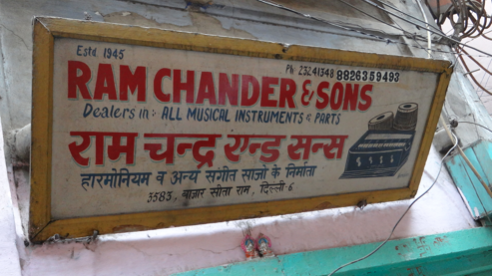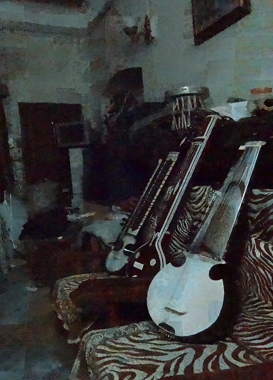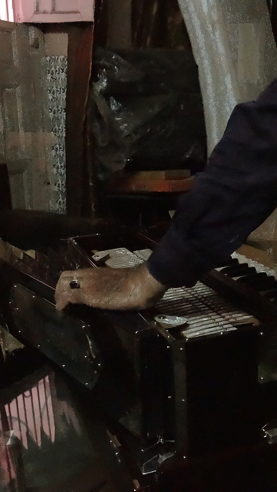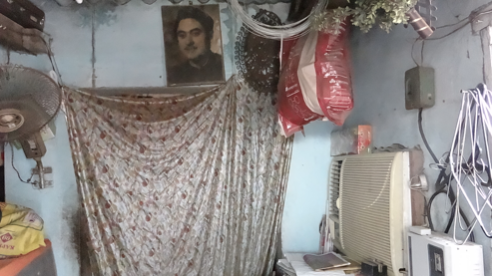
INTERVIEW
A Roomful of Silence
29 June 2016・Chahat Rana
 This shop existed in a street that we paused to photograph. Its tall buildings converged to the point where I could imagine residents taking a single step into the balcony of their neighbors. While I imagined this absurdity, my attention was brought towards ‘Ram Chander and Sons’. A shop more cramped than the aforementioned street with its fascinating trans neighbor interaction possibilities.
A quick look around showed a weary time weathered fellow, laying the chalices of his morning ritual: setting up shop. Mr Ramesh Chandra Sharma was older than the shop itself. He told us he was on his own. No future generation would take up the work that his families had done since decades, almost a century. This work would die with him, he says nonchalantly. ‘No one is interested in the hard labour required in the kaarigari.!’ Grim nodding follows, expressing a comprehension that didn’t really exist until we saw the harmonium workshop.
This shop existed in a street that we paused to photograph. Its tall buildings converged to the point where I could imagine residents taking a single step into the balcony of their neighbors. While I imagined this absurdity, my attention was brought towards ‘Ram Chander and Sons’. A shop more cramped than the aforementioned street with its fascinating trans neighbor interaction possibilities.
A quick look around showed a weary time weathered fellow, laying the chalices of his morning ritual: setting up shop. Mr Ramesh Chandra Sharma was older than the shop itself. He told us he was on his own. No future generation would take up the work that his families had done since decades, almost a century. This work would die with him, he says nonchalantly. ‘No one is interested in the hard labour required in the kaarigari.!’ Grim nodding follows, expressing a comprehension that didn’t really exist until we saw the harmonium workshop.

Mr Ramesh as a toddler in the middle row.
Mr Ramesh shows us an old photograph, the only embellishment upon the tiny walls of the shop. It was a black and white picture of the members of the Rati Ram and Sons firm. All had migrated to Chandni Chowk in the early 40’s. Many descendants still resided in the old havelis of Bazzar Sita Ram road, but just about two individuals still build these instruments. We met up with Mr Vinod Sharma, a third generation harmonium maker, who was kind enough to show us his work and deal with my vast ignorance regarding his work. Mr Ramesh is a distant uncle of his. ‘There was a time, when all 40 members of my family worked in a haveli, making harmoniums! People migrated from our village in search of work and they found it here.’ This harmony however disintegrated with the firm dissolving in 1972. Now only scattered individual efforts barely thrive in the business.
The storage rooms
Arriving at the haveli, I get to explore a tiny labyrinth full of old, repaired and yet to be repaired musical instruments. Tiny rooms lead to even more tiny rooms. Much like a beacon reminding the visitor of a dying, but a once flourishing past. There was nothing mouldy or untoward; dust lay thick on precariously balanced piles of harmoniums. I carefully treaded my way through this display of disuse into the last storage room, which doubled as a cozy living room. There we sat to have a chat amidst silent instruments and rickety fans.
The living room and its instruments
How did you learn to make harmoniums? I don’t only make harmoniums. I make guitars and other traditional string instruments like the Sitar, the saroj and more. You know these? Here, I can show you. Music follows. Short Riffs played on at least three different instruments. Most of which I couldn’t name. As if I, a self-proclaimed lover of music of ‘all genres’, needed to evidence my deplorable ignorance further. Again, my self-depreciation only leads to the inescapable jaws of self-absorption and before I start losing sight of what existed beyond ego, Mr Vinod resumes the conversation. However, very few purchase or place an order for any of these string instruments. You see, these are manufactured outside the country. Harmoniums are manually crafted by individuals and paid kaarigars. There is no mass production. ‘Hamara koi sasta chinese maal nahi hain! Khub mehnat hain. Factory mein nahi banta yeh.’ I grew up watching my father and grandfather doing the work and so I learnt. This is not something you can take up as a hobby. You can’t start learning the craft at your age, for example. You could never gather the patience and skill to create this. How do you create this? Well….. the supplies come in the form of these sheets. I cut and paste these together to make each piece. Basically. I am sure its not even close to being basic! Haan, matlab….. I will show you my workshop. Perhaps that will give you a better idea. Look at these keys for example. See here. They are not like those smooth piano keys. It’s Italian nylon. I paste it myself. I notice the vibrant orange border, standing out in the otherwise demure setting. I ask him about the border. Yes, I painted this too. The plate on the front with my name on it. I have to engrave that myself too. I attach the plate to the most expensive ones. It is beautiful, I tell him. I wasn’t lying, merely suppressing my contempt towards things that are branded as our own. For what we possess we take for granted. Like a rich history of musical tradition, perhaps.
Mr Vinod playing the harmonium
We climb us a steep flight of stairs and some more to reach his workshop. I catch my breath under the guise of tying my shoelaces as he continues to tell us how the younger generation was not ready for the strenuous work and patience that was required of his craft. ‘You are generalizing sir!’ I want to say, but I don’t have the breath to do more than finish the ascent to his tiny workshop. It was indeed tiny, fitted with even more instruments, scraps and tools on the right side. Also, what seemed to be the edge of a table, peeking out under spare parts, implements and such. He commenced a quick and succinct narration on the technicalities of his work, which he too was aware I didn’t have the mental facilities to register. But that itself was enough to prove the point. This is work that you and I couldn’t begin to comprehend. The least we could do is to acknowledge its relevance.
The Workshop
The left corner of the chamber has an air conditioner. The only aid that the contemporary times have provided him and his art with. All other potential is lost in a convenient abyss of ignorance. How many of us have wondered where our musical instruments come from? We all jump straight to learning the chords of ‘Knocking on Heaven’s Door’. DU is such a big university. People die to get their kids admitted. Are you aware of the Music Department? Are you aware that there are no harmonium course as of now? They say they will introduce them in the future. But really… it is such a big country, but no institutional aid for our field of work! Sab PHD’s le lete hain! But who knows how to make instruments? There is not a single institutional appointment for people like me. This is all I can do. I realized I hadn’t even considered that there is a department of music in the university. Aren’t extra curricular endeavors and achievements merely the appendage that facilitates students into another godforsaken quota? Sadly, it is majorly so. Kaarigars have stopped coming. Who can blame them? It is too less for money in exchange for their long hours of delicate craftsmanship. So why indeed do do you do it? I inquire to myself. The truth is that there is no reason. Nothing that would provide an incentive or reward or gratification enough. An underappreciated, furthermore, unrecognized art form is dying. He keeps it alive till he can. We turn a blind eye for our eyes are solely reserved to gaze at the bright future of our developing country. Meanwhile, we are too busy caging our traditions into museums and limiting our art to short, stagnant performances. The future shall be built on a foundation and that foundation exists. But, inexplicably, we seem to be too eager to discard it.Next article: Cosmology & Cultural Cognition – Prelude
 |
Next Post
Previous Post
CATEGORIES
CONTRIBUTORS
BLOG TEAM
Chahat Rana
Blog Editor
Samuel Buchoul
Web Design

